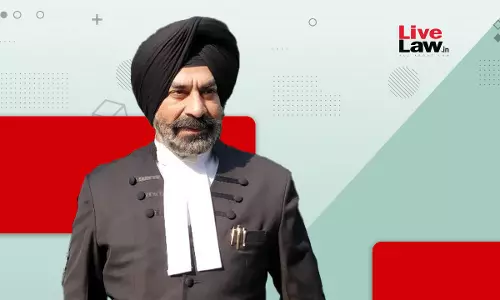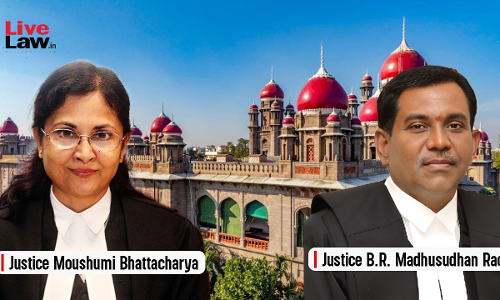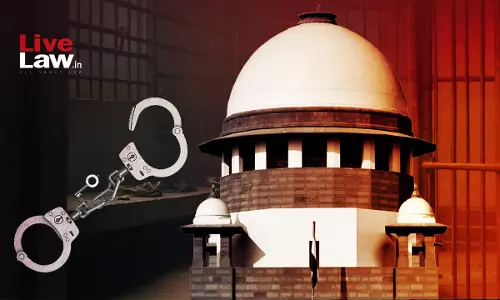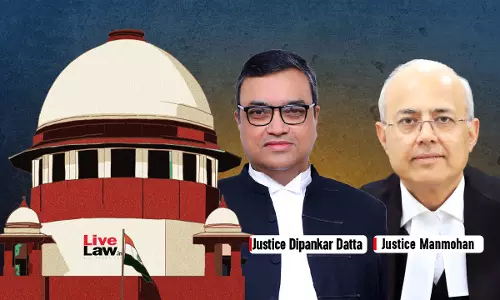SC Rejects Govt Stand On Creating New Posts In District Judiciary: Issues Directions [Read Judgment]
![SC Rejects Govt Stand On Creating New Posts In District Judiciary: Issues Directions [Read Judgment] SC Rejects Govt Stand On Creating New Posts In District Judiciary: Issues Directions [Read Judgment]](https://www.livelaw.in/cms/wp-content/uploads/2015/10/SC-min.jpg)
SC rejected the government stand that new posts in district judiciary should be created only after 90 per cent of the sanctioned strength has been filled up.The Supreme Court in Imtiyaz Ahmad vs. State of UP, has ruled that the required judge strength of the district judiciary shall be computed for each state in accordance with the interim approach suggested by the National Court...
SC rejected the government stand that new posts in district judiciary should be created only after 90 per cent of the sanctioned strength has been filled up.
The Supreme Court in Imtiyaz Ahmad vs. State of UP, has ruled that the required judge strength of the district judiciary shall be computed for each state in accordance with the interim approach suggested by the National Court Management Systems Committee (NCMSC).
The bench comprising Chief Justice of India TS Thakur and Justice DY Chandrachud disagreed with the government stand that new posts in district judiciary should be created only after 90 per cent of the sanctioned strength has been filled up. The court said many of the delays in this regard are not in the control of the high courts.
In a note submitted before the court, Professor Dr G Mohan Gopal raised certain concerns about the rate of disposal method suggested by the Law Commission and suggested that the clearance of backlog is not the sole or central basis for determining judge strength.
According to the NCMSC, following parameters are also to be considered viz. (i) rate of case clearance: the number of cases disposed of as a percentage of institution; (ii) on time disposal rate – the percentage of cases resolved within an established time frame; (iii) pre-trial custody periods wherein an under-trial is in custody pending trial of a criminal case; and (iv) trial date certainty – the proportion of important case processing provisions that are held according to the schedule finalised.
The court, accepted a stipulation suggested by the Central government, which broadly agreed with the above suggestions made by the NCMSC, to the above method and observed that an endeavour should be made to ensure that real time data is duly compiled and made available online by the high courts as part of the National Judicial Arrears Grid.
However, the court refused to accept the second stipulation suggested by the Central government that new posts should be created only after 90 per cent of the sanctioned strength has been filled up. The bench observed: “For one thing, filling up of vacancies in the district judiciary is an on-going process. In many states, the process of filling up posts is pursued in conjunction with the State Public Service Commissions. Many of the delays are not in the control of the High Courts. Moreover, it is necessary to provide for the required judge strength in every state district judiciary so as to facilitate the creation of infrastructure. In several states, the available infrastructure is inadequate and insufficient to meet even the existing judge strength. Hence, a scientific assessment of the required judge strength will form the basis of ensuring that the state governments put into place the infrastructure required for tackling judicial delays.”
The court then ordered that until the NCMSC formulates a scientific method for determining the basis for computing the required judge strength of the district judiciary, the judge strength shall be computed for each state, in accordance with the interim approach indicated in the note submitted by the NCMSC chairperson.
The Bench has issued the following Directions:
i) Until NCMSC formulates a scientific method for determining the basis for computing the required judge strength of the district judiciary, the judge strength shall be computed for each state, in accordance with the interim approach indicated in the note submitted by the Chairperson, NCMSC;
ii) NCMSC is requested to endeavour the submission of its final report by 31 December 2017;
iii) A copy of the interim report submitted by the Chairperson, NCMSC shall be forwarded by the Union Ministry of Law and Justice to the Chief Justices of all the High Courts and Chief Secretaries of all states within one month so as to enable them to take follow-up action to determine the required judge strength of the district judiciary based on the NCMSC interim report, subject to what has been stated in this judgment;
iv) The state governments shall take up with the High Courts concerned the task of implementing the interim report of the Chairperson, NCMSC (subject to what has been observed above) and take necessary decisions within a period of three months from today for enhancing the required judge strength of each state judiciary accordingly;
v) The state governments shall cooperate in all respects with the High Courts in terms of the resolutions passed in the joint conference of Chief Justices and Chief Ministers in April 2016 with a view to ensuring expeditious disbursal of funds to the state judiciaries in terms of the devolution made under the auspices of the Fourteenth Finance Commission;
vi) The High Courts shall take up the issue of creating additional infrastructure required for meeting the existing sanctioned strength of their state judiciaries and the enhanced strength in terms of the interim recommendation of NCMSC;
vii) The final report submitted by NCMSC may be placed for consideration before the Conference of Chief Justices. The directions in (i) above shall then be subject to the ultimate decision that is taken on receipt of the final report; and
viii) A copy of this order shall be made available to the Registrars General of each High Court and to all Chief Secretaries of the States for appropriate action.
Read the Judgment here.
This article has been made possible because of financial support from Independent and Public-Spirited Media Foundation.





